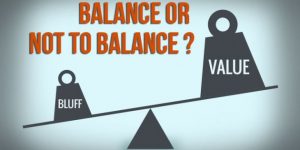
After discussing the idea of centrality in poker, we have crossed the boundary of the holistic poker theory. This area is known for widely discussed fundamental ideas: balance, exploitation, game theory, and so on. But in order to truly understand and use this knowledge, we need to understand their basics. One of the main concepts that often confuses players is balance, so let's start with that.
So, what is balance?
We can start by saying that essentially it is the idea that you need to maintain a balance between bets, bluffs, and value hands. A good start, but everything is much more subtle.
The truth is that balance is an undefined concept that people often use to fill gaps in their thinking about poker. If you ask someone, “Why did you just check back a set?” or “Why are you betting with a medium pair?” “Why are you bluffing on the river?” often confused mid-level players will answer that they do it to maintain balance. But if you asked them to define the concept, they couldn't give a precise answer. This word is thrown around quite liberally.
Balance can be divided into two main ideas, depending on what the word is used for. The first idea is this: for a range to be balanced, it must contain both value hands and bluffs. The second – for a range to be balanced, it must include both the strongest and medium-strength hands. If you have too much of one and too little of the other, you are unbalanced in this area.
Let's look at this definition more closely. What exactly does it mean that a range must have both value hands and bluffs? How many should there be? Is one bluff per 100 hands enough? So, here we come to the point where it appears that the idea of balance is closely related to another concept – “unexploitable” play. This concept comes from game theory, and it simply means that the strategy we use cannot be exploited by others. It can never lose to any other strategy. For example, if we play the game rock-paper-scissors, the unexploitable strategy (also known as GTO-game theory optimal) is to randomly make each move 33% of the time. Using this strategy, no matter how the opponent plays, on average, they will be the loser.
Most poker players end their careers equating balance with unexploitable play. They think that for there to be balance, their playing range must be unbreakable, “perfectly balanced.” This would mean that you should create a range where, when you make a pot-sized bet on the river without hitting any draw, you bluff 33% and allocate 66% to value bets.
Presented this way, balance seems very attractive and you might think it will solve all problems. But there are two misconceptions that players often encounter when thinking about balance. The first is assuming that you are either completely balanced or completely unbalanced. The second is that balance is inherently valuable, although in reality, it is not.





